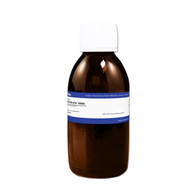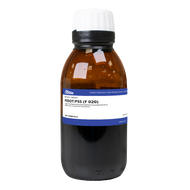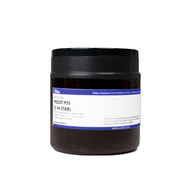PEDOT:PSS Conductive Polymer

Jump to: Popular PEDOT:PSS | Choose the right PEDOT | New types of PEDOT:PSS | Why is PEDOT:PSS important? | PEDOT Complex | Applications | Structure
PEDOT:PSS, or poly(3,4-ethylenedioxythiophene) polystyrene sulfonate, is a blend of two distinct polymers: poly(3,4-ethylenedioxythiophene) (PEDOT) and polystyrene sulfonate (PSS). This combination forms a p-type semiconductor which is highly valued for its ability to conduct electricity, its ease of processibility, and its transparency in the visible spectrum. As a result, PEDOT:PSS is an extremely attractive material for use in many optical and electronic devices.
PEDOT is a conjugated polymer which is formed of 3,4-ethylenedioxythiophene monomers joined at 2,5-positions of each five-membered thiophene ring to create linear polymer chains. It is the conductive component of PEDOT:PSS and has impressive mechanical flexibility. Pristine PEDOT is insoluble in many solvents so it requires the presence of a stabilizer and dopant molecule, such as PSS, in order to be synthesized in water or other solvents. PSS is a polymer surfactant with a styrene backbone and a sulfonate group (-SO3H) acting as the pendant unit. PSS coats the insoluble PEDOT molecules, creating nano-size particles of PEDOT:PSS, which form a stable colloidal dispersion in water. PSS is currently the most successful PEDOT counterpart but other options are available.
Popular PEDOT:PSS
Browse more PEDOT polymer blends
Choose PEDOT:PSS and PEDOT Materials
There are many different types of PEDOT:PSS and PEDOT based polymer formulations. Manufacturers can fine-tune the properties of PEDOT materials, including the conductivity, flexibility, and stability, to meet functional demands across different applications.
It is important to choose a PEDOT material with the right properties for your desired application to ensure optimal performance.
Ratio of PSS
One of the most important differences between PEDOT solutions is the ratio of PEDOT to PSS. Changing the ratio can drastically affect the properties of your PEDOT material. When you alter the ratio of PEDOT to PSS, you can significantly impact the material’s conductivity, transparency, flexibility, and even its stability in different environments.
A higher PEDOT content generally enhances electrical conductivity but might reduce the material's film-forming ability and flexibility. Conversely, increasing the PSS content often improves the solution's processability and transparency but can decrease conductivity.
| Type | Ratio PEDOT:PSS (w/w) | Conductivity | Stability of Suspension | Applications |
|---|---|---|---|---|
| AI 4083 | 1:6 | Medium | Medium | Organic and inverted PSCs and OLEDs as a hole transport material |
| PH 1000 | 1:2.5 | High | Low | Electrode or transport layer in device |
Solvent
Solvent choice is also important when selecting a PEDOT complex. Most PEDOT:PSS solutions are dispersed in water. However, other PEDOT complexes use alternative stabilizers to PSS, enabling dissolution in different solvents. This may be a useful alternative if you are working with materials that are hydrophobic or that degrade when exposed to water.
Additives
While other PEDOT:PSS solutions also incorporate additives to adapt the solutions for specific purposes, such as for deposition onto fabrics or to change its thermoelectric properties.
New Types of PEDOT:PSS
While PEDOT:PSS PH 1000 and AI 4083 have been widely popular, new formulations are now expanding the material’s applicability. Depending on your application, substrate, coating technique, and desired properties, different PEDOT:PSS types ensure optimal performance:
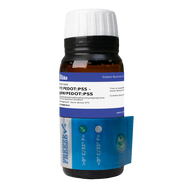
HY E PEDOT:PSS - AgNW/PEDOT:PSS
Highest Conductivity
Water based hybrid dispersion of silver nanowire additives and PEDOT:PSS

F HC Solar PEDOT:PSS
High Conductivity
Specifically designed for OPVs, creating a low contact angle surface

P T4 PEDOT:PSS
Highly Versatile
Easily coated on various substrates via different coating techniques
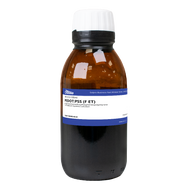
F ET PEDOT:PSS
High Conductivity
Contains binder resins and functional additives for better film quality and processability

P JET (OLED) PEDOT:PSS
For Inkjet Printing
A hole injection layer and antistatic material suitable for OLEDs and QLEDs
Browse more PEDOT polymer blends
Why is PEDOT:PSS Important?
PEDOT:PSS is one of the most popular conductive polymers due to its impressive blend of material properties. PEDOT:PSS has many attractive qualities, including:
PEDOT Complex
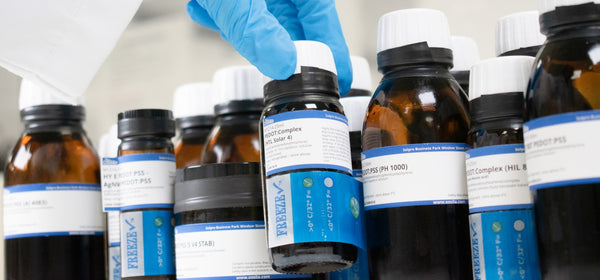
Most PEDOT:PSS formulations are aqueous, which is not ideal for devices with moisture-sensitive active layers, such as perovskite solar cells and OLEDs.
For devices requiring a conductive layer that won’t compromise the active layer due to water exposure, PEDOT complexes in alternative solvents are recommended.
Our PEDOT complexes come in:
Toluene - HTL Solar 3 PEDOT Complex
Butyl benzoate - HIL 8 PEDOT Complex
Anisole - HTL Solar 4 PEDOT Complex
These solvents promote highly crystalline thin film formation, enhancing conductivity while also improving the wetting and coating of subsequent layers.
PEDOT:PSS Applications
PEDOT:PSS is by far one of the most successful conductive polymers. It is compatible with many solution processing techniques (including dip coating, spin coating, slot die coating, spray coating, blade coating, inkjet printing, and screen printing). This means you can coat a range of substrates with PEDOT:PSS solutions, rigid or flexible, regular or irregular.
In scientific research, uses of PEDOT:PSS span from fundamental research to practical applications, including sensors and biosensors, supercapacitors, anti-static and electrically conducting coatings, and thermoelectric materials. It is also widely used for industrial applications. For example, both aqueous and non-aqueous deep-blue PEDOT:PSS dispersions are now commercially available from Heraeus Clevios™ and Agfa Orgacon™.
Perovskite Photovoltaics
PEDOT:PSS has been used as a hole extraction material in inverted PSC devices. This material facilitates the extraction of charge carriers at the interface between the transparent conductive oxide and the active perovskite layer.
Organic Photovoltaics
PEDOT:PSS has long been used in OPV fabrication, often used in combination with materials such as P3HT and PCDTBT. To this day, it remains a popular material choice for polymer solar cell research.
Organic Light Emitting Diodes
The use of PEDOT:PSS in organic light emitting diodes, as a well-established standard hole injection material, has been widespread for over a decade. Recent work still uses PEDOT:PSS due to its deep work function. This allows for efficient charge injection into white emitting polymers as well as host materials for thermally activated delayed fluorescence materials.
Transparent Conductors
PEDOT:PSS is a potential replacement for expensive transparent metal oxides, such as ITO and FTO. Its effectiveness in both organic photovoltaic and perovskite photovoltaic devices has been demonstrated. In addition, in combination with metallic grid structures, it is possible to achieve sheet resistances comparable to metallic films.
PEDOT:PSS Structure
Although the characteristics of PSS are well defined, PEDOT:PSS has a much more complex structure. The intimate association of two polymers in solution leads to some interesting dynamics in the suspension and in the subsequent thin film. One term for this intricate combination of PEDOT and PSS is a “chain structure entanglement”.
During synthesis, it seems that PEDOT synthesizes onto the PSS template. In the resulting suspension, small segments of PEDOT are in close contact with PSS bundles bound by Coulomb forces. These entangled PEDOT:PSS bundles form a colloidal suspension of gel particles in water where:

- Hydrophobic PEDOT populates the inner core
- Hydrophilic PSS makes up the outer layer
When deposited into a thin film, the film morphology is driven by this chain structure entanglement. The PEDOT:PSS gel particles will form pancake-like structures, with these bundles stacking on top of one another in the thin film.
The morphological and electronic properties of a PEDOT:PSS film depend on the formation of these gel particles and their stacking. Therefore, film properties are dependent on many factors including:
- PEDOT and PSS ratio and synthesis method
- PEDOT:PSS deposition and processing methods
- Any additives in the precursor solution
- Any pre- and post-treatment of the deposited films
Learn More
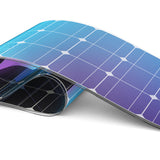 PEDOT:PSS Applications
PEDOT:PSS Applications
PEDOT:PSS stands out as a promising conductive polymer due to its large range of conductivities, transparency, flexibility, and ease of processing.
Read more...PEDOT synthesis involves the oxidative chemical or electrochemical polymerization of EDOT monomer.
Read more...References
Huseynova, G., Hyun Kim, Y., Lee, J.-H., & Lee, J. (2019). Rising advancements in the application of PEDOT:PSS as a prosperous transparent and flexible electrode material for solution-processed organic electronics. Journal of Information Display, 21(2), 71–91. https://doi.org/10.1080/15980316.2019.1707311
Wang, Z., & Liu, R. (2023). PEDOT:PSS-based electrochromic materials for flexible and stretchable devices. Materials Today Electronics, 4, 100036. https://doi.org/10.1016/j.mtelec.2023.100036
Contributors
Written by
Application Scientist
Application Scientist
Diagrams by
Graphic Designer
